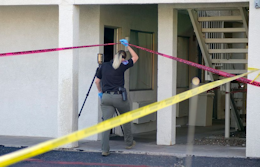|
Gang Violence Drives Rise in Murder Rates in Some U.S. Cities
 Summer
brings an unusual crime pattern; some police say pandemic closures of
anti-violence programs are a factor Summer
brings an unusual crime pattern; some police say pandemic closures of
anti-violence programs are a factor
Gang shootings are driving an increase in homicides this year in Los Angeles
while robberies and burglaries are dropping, an unusual crime pattern reflected
in a number of cities across the country.
From the start of the year through the first week in August, Los Angeles had
232 homicides, a 22% increase over last year. About 58% of those were
gang homicides, a 28% increase over last year, according to police
officials.
Deputy Chief Kris Pitcher said pandemic-related shutdowns of city-sponsored
and other efforts to stop retaliatory shootings between gang members were a big
factor in the rise.
Nationwide, homicides rose 21% in 66 of the country’s largest cities
during the first half of the year, according to the Major Cities Chiefs
Association.
The causes of the homicide rise over the past year have been fiercely debated
and not well studied. Some politicians and police officials have said that a
police pullback has been a factor in places like Portland, Ore., which
has seen a large increase in homicides. Some researchers blame frayed
relations between law enforcement and Black communities after high-profile
police killings, such as that of George Floyd in Minneapolis. Others point to
the stress from the Covid-19 pandemic and the temporary shutdown of
the court system.
&uuid=(email))
But the rise in killings that began last summer during the pandemic and the
nationwide protests over social justice and police brutality has slowed a bit
in recent months, according to a separate study of 29 cities by the Council
of Criminal Justice, a think tank focusing on criminal-justice policy and
research.
While summertime numbers point to a plateauing, homicides are still well above
pre-pandemic levels. Chicago, for example, had 105 homicides in July compared
with 107 in 2020 and 44 in July 2019. In Dallas, homicides dropped to 19 in July
of this year from 25 last July after rising during the first half of the year;
there were 12 in July of 2019.
At the same time, several other categories of crime have dropped in the first
half of the year like robberies, down 6%, and residential and
nonresidential burglaries, both down 9%, according to the study.
Criminologists attribute those drops to more people working from home during the
pandemic, making homes less vulnerable to burglaries, and to less foot traffic
in cities, which has meant fewer opportunities for robberies.
The disruption in the work of nonprofits and city programs that seek to tamp
down violence appears to have played a role in some cities. Such softer
approaches were long ignored by criminologists, but in 2017, Patrick Sharkey, a
sociology professor at Princeton University, found that every 10 additional
organizations per 100,000 residents focusing on crime and community life led to
a 9% reduction of the homicide rate in a study of 264 cities that spanned 20
years.
In Los Angeles, the birthplace of gangs like the Bloods and Crips, a combination
of gang intervention programs and a more surgical approach to violent crime by
the Police Department helped turn the city from one of the most dangerous in the
1990s to
one of the safest in the past decade. The pandemic halted many of those
efforts.
latimes.com
|